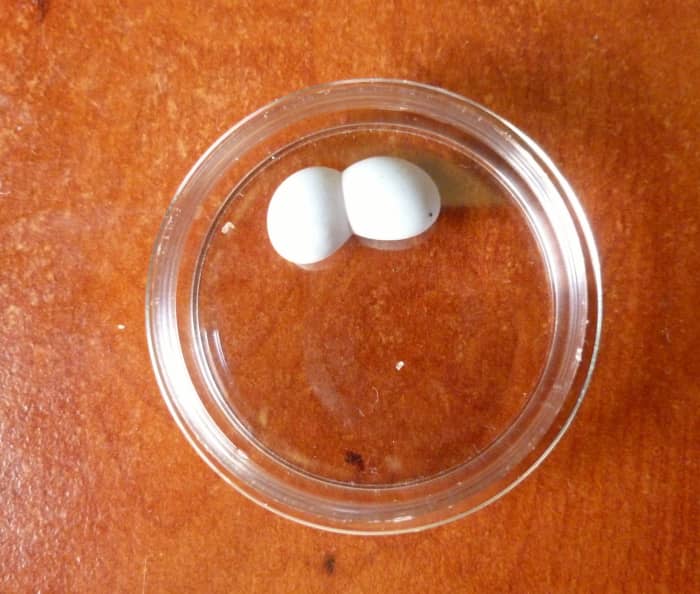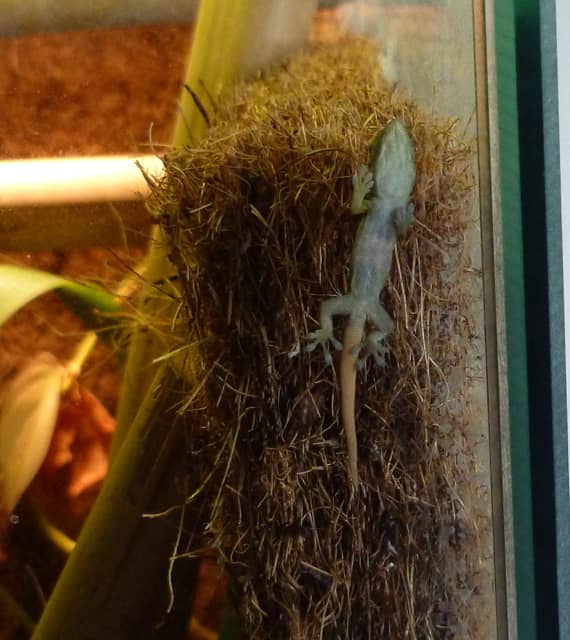I Found a Baby Gecko What Do I Feed It
I am an experienced mean solar day gecko breeder and tree frog keeper who takes interest in the biological sciences.

A newly hatched neon twenty-four hours gecko infant is tiny.
aa lite
Breeding Geckos Is Easy. Raising the Offspring Is Hard!
If y'all have a compatible pair of geckos, y'all will know that breeding them is very easy. As long as you maintain them in the correct conditions and they are good for you, you but need to leave them to their ain devices, and you will soon hear the patter of tiny gecko feet!
The claiming actually starts when the little geckos hatch. In one case the eggs are laid, the parents relinquish all responsibility for caring for them. In fact, in many species, once the eggs hatch, the parents can pose a serious risk to their babies.
At the same time, the petty geckos come out of their eggs fully formed and are able to look afterwards themselves. The problem is in providing them with the right tropical environment that is right for their species. Of course, this is the aforementioned environment that you've set up for their parents, and so you should already know how to practice information technology. Because the hatchlings are so small, however, whatever deviations from the correct settings will affect them a lot more than than their parents.

Gecko eggs
aa light
Practise You Need to Move the Eggs to an Incubator?
The outset decision that yous need to make when convenance geckos is whether you will just keep the eggs in their parents' terrarium, or remove them to be incubated exterior. You lot tin now buy specialist incubators for keeping reptile eggs at a tightly controlled temperature and humidity. They are not exactly cheap, however. Many people tin can besides build their own DIY incubators.
In my experience convenance two species of Phelsuma day geckos, the eggs will do pretty well in the adults' enclosure. After all the conditions in it are set up to be what the geckos need.
I did have one case of the female gecko "eating" her eggs, or rather licking them until they bankrupt and eating the shells. This happened probably because she didn't have quite enough calcium in her nutrition. Notwithstanding, on the whole the eggs are quite safety until they hatch.
The trouble with removing the eggs is the possibility of damaging them in the procedure. The females ofttimes hibernate them in difficult to access places in the tank. This is particularly true of species in which the eggs are glued to a surface.
My geckos invariably lay their eggs in the hollows of bamboo tubes with which their tanks are furnished. It might be possible to remove these eggs in the example of my Phelsuma klemmeri geckos, which are non-gluers, simply P. cepediana glue their eggs to the inside of the tubes. Honestly, I cannot imagine how I would become well-nigh removing them.
Apart from breaking the eggs, there is the danger of changing their orientation. If you plough the egg "upside down" later the embryo starts developing, this tin can cause serious defects in the forming gecko. If you are removing the eggs, it is advised to mark the "up" side of them, so you can reproduce their orientation afterwards.
The big advantage of using an incubator is that for nearly geckos their sexual practice is determined by the temperature in which the eggs are left. Hence it is possible to control whether yous get females or males, by changing the temperature of the incubator.

I institute this baby in the cepediana gecko terrarium just a few days ago.
aa light

Daddy cepediana is rather partial to his offspring for breakfast.
aa low-cal
Removing Infant Geckos From Their Parents' Tanks
If you choose to leave the eggs in the main terrarium, so the work really starts when the baby geckos hatch. I have to admit that in the example of neon day geckos, P. klemmeri, at that place is very little work, I but leave them in their parents' tank. However, this species is very unusual in that they don't pay much attending to the babies, and very rarely eat their own offspring.
Read More From Pethelpful
In the case of the other species of day gecko I continue, and in fact the vast majority of geckos, the hatchlings are in great danger of being snacked on by daddy or mommy. I have yet managed to think a large number of cepediana babies from the adults' tank, the youngsters seem to be well aware of the danger, and unremarkably run to hide backside the background every bit soon as they can.
I did notice a couple of babies with missing tails (which regrow), and I did in one case rescue a youngster literally from his male parent'south jaws (it didn't seem to exist permanently damaged and went on to grow into a fine gecko). However, the bulk of geckos recovered take been fine.
One useful fob, if you are lucky and the eggs are glued to the terrarium glass, is to encompass them with a plastic cup, which tin can exist stuck over them. This fashion, when the eggs hatch the adults can't get to them, then they are piece of cake to recollect. However, this is impossible if the eggs are hidden in bamboo.

The baby gecko "nursery" setup
aa lite
Housing for Baby Geckos
Housing for the babies took me a while to figure out. One matter that might not be very obvious when you expect at the sweetness tiny geckos is that they are territorial even at that immature age, and should be housed separately. Ordinarily there are ii eggs laid at a fourth dimension, and there can exist several pairs hatching throughout the summer, leaving you lot with quite a few geckos to look after. Ownership special tanks for them all can finish up quite expensive, non that in that location are that many options for good nursery tanks on the market anyway.
You lot do really need a small tank, y'all want to be able to observe the baby frequently at starting time and don't desire information technology to go lost in a big tank. Some other consideration is to brand certain the tiny gecko tin't escape from the terrarium.
In the end I have settled on housing the baby geckos in small "critter keeper" boxes. They are a adequately good size, are ventilated, and are cheap so they can be bought in majority. At first, I embrace the meridian with a "cyberspace" (I think it might have been a piece of net drape I sacrificed for this), to prevent the lizard from escaping.
The lesser of the tank is covered with a thick layer of orchid bark, just like the adults' tank. Yous could but use a kitchen towel, simply the absorptive bedding helps maintain loftier humidity. I usually stick some pothos into the bedding, and put a few minor bamboo sticks for the geckos to climb. Finally, rut and light are provided by a minor fluorescent tube placed over the critter keeper.
The only problem with this arrangement is that I wish it were more than vertically oriented since the geckos I continue are arboreal. The elevation opening chapeau is likewise less than ideal, especially with the net. I am always worried that the geckos will jump out when I open the lid to feed them or spray them with water.
Another potential trouble that I used to worry about was that the net would block a lot of the UV light, which the geckos need to make Vitamin D, necessary for calcium absorption. Still, I supplement their nutrient with the vitamin, and I've never had any issues with the geckos developing os abnormalities or showing signs of metabolic bone disease.
Feeding Gecko Hatchlings
Newly hatched geckos eat the same food as their parents, insects and pureed fruit, except obviously the insects have to be smaller.
I ever offset hatchlings on babe food fruit puree, mixed with calcium and vitamin D supplement. I will put a dish of this in their plant nursery simply also dab small amounts of information technology most to where they are sitting. They will become attracted by the scent and kickoff licking it. One time they get a taste for it, they will ordinarily seek out the master dish.
I've noticed that they are not very interested in insects the first few hours afterward hatching, so I don't give them whatever until the next day. I ordinarily starting time them on drosophila fruit flies, I don't give them crickets until they are a little bit bigger, perhaps 2 weeks after they've hatched.
The young geckos need to be fed every day, with gutloaded insects, and their food is supplemented with calcium and Vitamin D daily too.
One-Day-Onetime Klemmeri Enjoying Mango Puree
Humidity and Shedding
Maintaining loftier humidity is important for virtually tropical geckos, but newly hatched ones are peculiarly susceptible to desiccating if conditions go too dry out, because of their small size they can lose wet very rapidly. Therefore information technology is very of import to spray the nursery enclosure frequently and ensure the humidity in it is at the upper limit of what the adults demand.
One of the showtime problems that occur when the humidity is not high plenty is problems with shedding their peel. Similar all reptiles geckos shed their pare all at once as they grow. If pieces of the old skin are not removed easily, they will harden and consequence in serious issues. Maintaining high humidity in the nursery tank will assist prevent these issues.
If a small gecko appears to have bug shedding, i way of helping it is to put it in a very humid environment. Line the bottom of a minor, ventilated container, like the boxes geckos are traded in, with soaking kitchen towels and place the little cadger in it, and place the box somewhere warm.
Sometimes you can assist with the shedding by removing the dead skin with tweezers. This tin be done for many reptiles, but it is very hard to practice for very immature geckos, they are tiny, fragile and can't actually be held without damaging them, and they are unlikely to sit still while you piece of work on them with tweezers.

The water spray bottle is your friend when raising geckos.
aa lite
This article is accurate and true to the all-time of the author's noesis. It is non meant to substitute for diagnosis, prognosis, treatment, prescription, or formal and individualized advice from a veterinary medical professional. Animals exhibiting signs and symptoms of distress should be seen past a veterinary immediately.
© 2013 aa lite
Natalie mclauchlan on May 18, 2019:
Ok I had a female gecko and she had ii eggs within of her simply she was outside on a stone and she wasn't moving i think she was dead because every time I was touch her she would lay backworks anyways I opened her tummy and got her eggs but I don't have an incubator all I have is a container with a lid with big holes and some modest rocks and newspaper towel .. can u tell me how to expect afterward them
Source: https://pethelpful.com/exotic-pets/How-To-Take-Care-Of-A-Newly-Hatched-Baby-Gecko
0 Response to "I Found a Baby Gecko What Do I Feed It"
Post a Comment